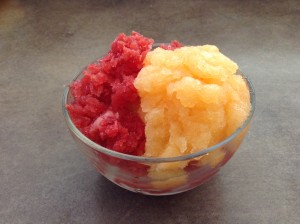Beets: What to Do With Them
/These versatile root veggies are one of my favourites! A classic storage, root veggie, you can find local ones throughout the winter. Beets have been making headlines lately because they may help boost exercise performance. Many kids like them because of their naturally sweet taste. However, people often wonder what the heck to do with them. So I’m sharing a couple of my favourite ways to use beets.
Grated – Raw Beets
Beets don’t even need to be cooked. Simply wash them, peel off the outer skin, and grate them into a salad.
It doesn’t get any easier than that!
Roasted Beets
When I’m turning on the oven to cook something, I often pop a few beets in at the same time – either for a warm side-dish today, or for chilled as a salad in the future.
- Wash beets and cut off any long tails or furry top bits.
- Cut a piece of tin foil large enough to wrap the beet in. Lay it on the counter, shiny side up. Pour a dollop of olive oil in the centre.
- Roll the beet around in the oil to coat it. Wrap the tin foil tightly around the beet.
- Repeat for each beet.
- Place wrapped beets on a cookie tray or in a baking dish.
- Roast until tender, how long this takes depends on the size of the beets and the heat of your oven – at 350 degrees F it may take as long as 2 hours; at 425 degrees F it may take as short as 45 min.
Beet and Bean Borscht
From: Pulses: Cooking with Beans, Peas, Lentils and Chickpeas
This is a fantastic, hearty and tasty, full meal in one pot, vegetarian borscht (perfect for Meatless Mondays). While the recipe takes a little longer to cook, it makes a lot of soup. And, this soup tastes great re-heated. Freeze leftovers (without the yogurt or sour cream topping) in small batches.
Makes 6 Litres
- 3 tablespoons canola oil
- 1 large onion, chopped
- 1 garlic clove, minced
- 2 carrots, diced
- 3 celery stalks
- 3 cups green cabbage, shredded (a Cuisinart or food processor makes shredding quick work)
- 3 cups beets, peeled and chopped
- 10 cups vegetable stock (home-made or lower sodium)
- 4 cups beans such as navy beans or white kidney beans (canned or cooked from dry)
- ½ cup canned or fresh tomatoes
- 2 tablespoons lemon juice
- 1 teaspoon fresh cracked pepper
- 1 bunch fresh dill (or parsley)
- plain yogurt or sour cream
Directions
- In a big soup pot, sauté onion and garlic in oil until softened.
- Add carrots, celery and cabbage and sauté for about 3 minutes.
- Add beets and stock and cook for about 1 hour or until beets are slightly tender.
- Add beans, tomatoes, lemon juice, pepper and dill. Warm thoroughly.
- Serve topped with a dollop of yogurt or sour cream.
- Enjoy!
Click here for more healthy recipes.






















